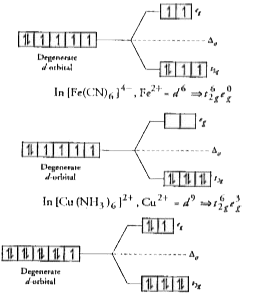Give the electronic configuration of the following complexes on the basis of crystal field splitting theory. [CoF6]3−,[Fe(CN)6]4−and[Cu(NH3)6]2+.Solution in Odia
According to spectrochemical series, ligands can be arranged in a series in the order of increasing field strength i.e. F−<NH3<CN−.
Hence, CN−andNH3 being strong field ligand pair up the t2g electrons before filling eg set.
In [CoF6]3−,Co3+=d6⇒t42g,e2g

Topper's Solved these Questions
- COORDINATION COMPOUNDS BOOK - ARIHANT PUBLICATIONCHAPTER - COORDINATION COMPOUNDS EXERCISE - QUESTIONS FOR PRACTICE Part II Long Answer Type Questions 7 Marks
9 Videos
- COORDINATION COMPOUNDS BOOK - ARIHANT PUBLICATIONCHAPTER - COORDINATION COMPOUNDS EXERCISE - QUESTIONS FOR ASSESSMENT Part II Multiple Choice Type Questions 1 Mark
2 Videos
- COORDINATION COMPOUNDS BOOK - ARIHANT PUBLICATIONCHAPTER - COORDINATION COMPOUNDS EXERCISE - QUESTIONS FOR PRACTICE Part II Short Answer Type I Questions 2 Marks
9 Videos
- CHEMISTRY IN EVERYDAY LIFE BOOK - ARIHANT PUBLICATIONCHAPTER - CHEMISTRY IN EVERYDAY LIFE EXERCISE - CHAPTER PRACTICE (LONG ANSWER TYPE QUESTIONS)
2 Videos
- D-BLOCK ELEMENTSBOOK - ARIHANT PUBLICATIONCHAPTER - D-BLOCK ELEMENTSEXERCISE - Chapter practice (Long answer type questions)
2 Videos
Similar Questions
Discuss the nature of bonding in the following coordination entities on the basis of valence bond theory.
[Fe(CN)6]4−
View SolutionWhich complex compound possesses sp3d2 hybridisation ?
View SolutionIdentify A and B in the given sequence of reaction. Also, write their IUPAC names and calculate spin only magnetic moment of B.
Fe3+(aq)Excess ofSCNθ−−−−−−−−→Blood red colour (A)
Excess ofF−−−−−−−−→Colourless (B)
View Solution(a) With the help of an example explain how do tranquilizers act as antidepressants?
View Solution(iii) Distinguish between alloy and amalgam.
View SolutionWhat is the correct electronic configuration of the central atom in K4[Fe(CN)6] based on crystal field theory
View SolutionSame number of unpaired electron is observed in which of the following complexes (a) [MnCl_(6)]^(3-) (b) [Fe(CN)_(6)]^(3-) ( c) [CoF_(6)]^(3-) (d) [Ni(NH_(3))_(6)]^(2+)
View SolutionGive the electronic configuration of the following complexes on the basis of crystal field splitting theory. [CoF_(6)]^(3-), [Fe(CN)_(6)]^(4-) and [Cu(NH_(3))_(6)]^(2+) .
View Solutionसंयोजकता आबन्ध सिद्धांत के आधार पर निम्नलिखित उप-सहसंयोजन मंडलों में आबंधन की प्रकृति का वर्णन कीजिए -
(a) [Fe(CN)6]4− (b) [FeF6]3−
(c) [Co(ox)3]3− (d) [CoF6]3−
View SolutionElectronic configuration of [Cu(NH3)6]2+ on the basis of crystal field splitting theory is
View SolutionWith the help of crystal field theory, predict the number of unpaired electrons in [Fe(CN)6]4− and [Fe(H2O)6]2+ complexes.
View SolutionGive the electronic configuration of the following complexes on the basis of crystal field splitting theory. [CoF6]3−,[Fe(CN)6]4− and [Cu(NH3)6]2+.
View SolutionGive the electronic configuration of the following complexes on the basis of Crystal Field Splitting theory. [CoF_(6)]^(3-),[Fe(CN)_(6)]^(4-) and [Cu(NH_(3))_(6)]^(2+)
View Solutionक्रिस्टल क्षेत्र सिद्धांत की सहायता से [Fe(H2O)6]2+ एवं [Fe(CN)6]−4 की तुलनात्मक विवेचना कीजिये।
View Solutionक्रिस्टल क्षेत्र सिद्धांत के आधार पर निम्न यौगिकों के गुणों का वर्णन कीजिए।
[Fe(H2O)6]3& [Fe(CN)6]3−
View Solutionक्रिस्टल क्षेत्र सिद्धांत की सहायता से [Fe(H2O6)]2+ एवं [Fe(CN)6]−4 की तुलनात्मक विवेचना कीजिए|
View Solution
